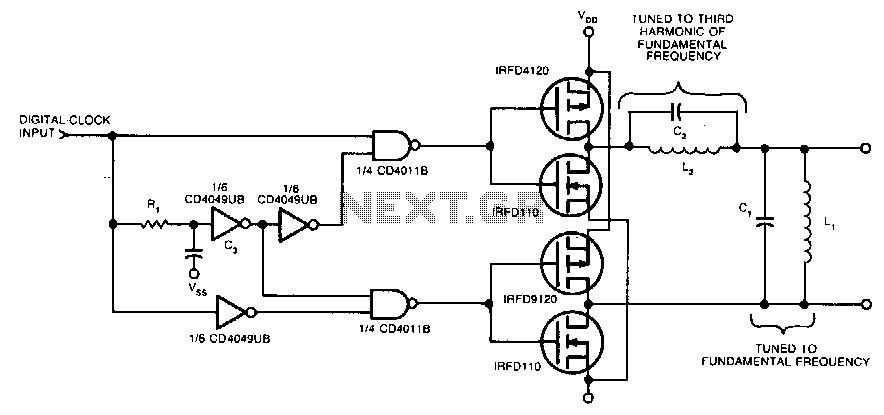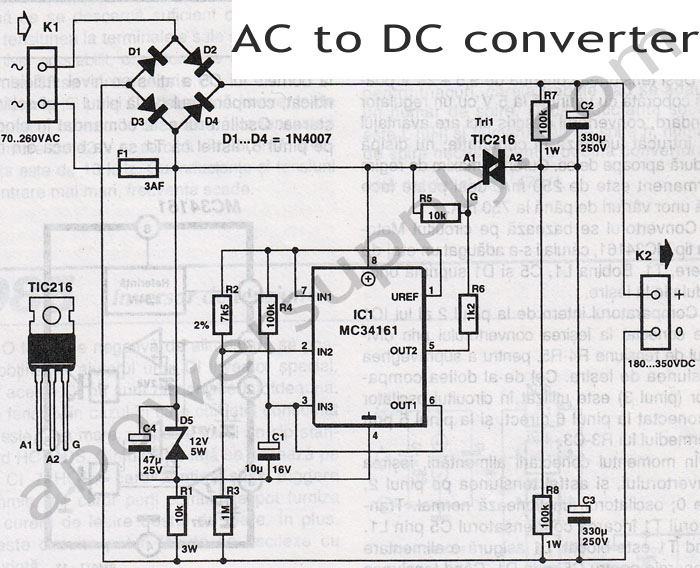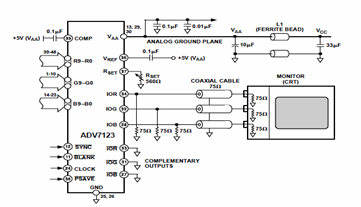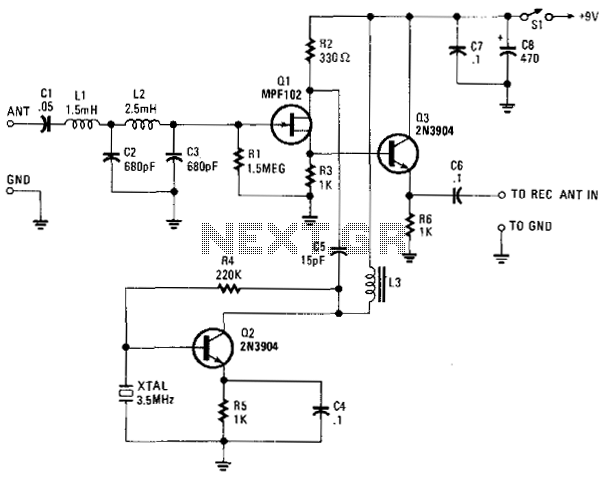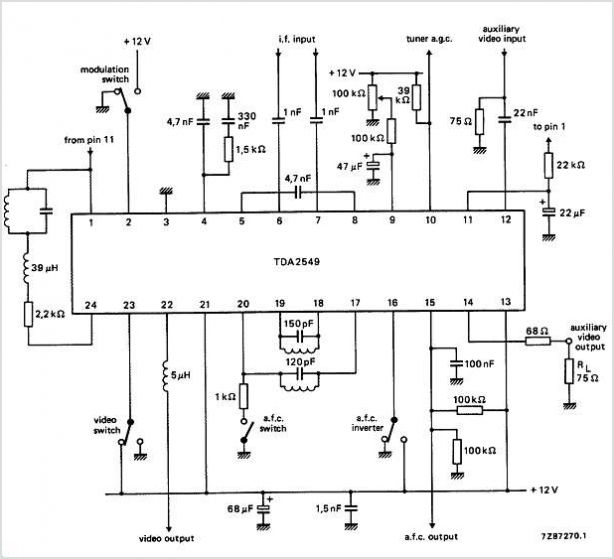
LM/MW converter for ham-only receivers

Prior to the development of broadband communication receivers featuring synthesized oscillators, high-grade ham band receivers utilized crystal oscillators and a variable intermediate frequency (IF) to cover relatively narrow frequency segments of 500-600 kHz. The schematic illustrates a circuit designed to modify most of these receivers to encompass the long-wave (150-400 kHz), standard (520-1600 kHz), and tropical (2.2-2.4 MHz and 3.2-3.4 MHz) broadcast bands, as well as various other notable stations within the 0.1-1.6 MHz and 2.0-3.6 MHz frequency ranges. The circuit incorporates untuned bandpass filters, a MOSFET mixer, and a crystal oscillator. The only control mechanism is a band-selector switch, while the tuning is performed by the receiver itself, functioning as a variable-frequency IF amplifier. A total of three crystals are sufficient for six bands, as the 80-meter ham band serves as a difference IF for the long-wave and medium-wave bands, and the 40-meter ham band acts as a sum IF for the short-wave bands. When a long-wave or medium-wave band is selected, a two-section low-pass filter with a 2.2 MHz corner frequency is activated to eliminate IF pickup, image frequencies, and prevent overload from nearby shortwave transmitters. Conversely, when a short-wave band is selected, a two-section high-pass filter with a 1.8 MHz corner frequency and a two-section low-pass filter with a 4.3 MHz corner frequency are engaged for similar protective measures. The design impedance for these filters is approximately 120 ohms, ensuring that the component values are practical and any mismatch in the driving source will not adversely affect the passband shape. Interestingly, the output mismatch of the filters has been observed to enhance the corner frequencies. The frequency ranges specified above, as well as those in the accompanying chart, pertain to a receiver with 600 kHz segments. For receivers utilizing 500 kHz segments, coverage of the standard broadcast band is restricted to 1500 kHz, which can be resolved by adding a 5.5 MHz crystal. The capacitors connected in series with the crystals serve as a means of excitation control, with values ranging from 20 to 62 pF in the unit depicted. These values are intended to yield an approximate 3 Vrms oscillator output voltage, which is then applied to the mixer’s injection gate via a low-pass filter to eliminate oscillator harmonics. An emitter follower with a voltage divider reduces both the mixer output level and impedance to suitable values for a high-impedance receiver. For higher output requirements, the resistive divider can be substituted with a transformer output. The circuit's input impedance is 75 ohms, necessitating a low-impedance signal source for driving. An ideal signal source is a loop antenna with a 75-ohm output, as ferrite-rod loops can be easily constructed to provide adequate coverage at the specified frequencies.
The circuit schematic is designed to adapt vintage ham band receivers for broader frequency coverage, facilitating the reception of various broadcast bands. The integration of untuned bandpass filters allows for selective frequency filtering, while the MOSFET mixer ensures efficient signal processing. The use of crystal oscillators provides stable frequency generation, crucial for maintaining signal integrity across the selected bands. The band-selector switch simplifies operation, allowing users to easily switch between different frequency ranges.
The filtering stages are critical for maintaining signal clarity, particularly in environments with potential interference from other transmitters. The implementation of low-pass and high-pass filters ensures that unwanted frequencies are attenuated, thereby enhancing the overall performance of the receiver. The choice of design impedance at 120 ohms is a practical consideration, as it allows for compatibility with a variety of signal sources without significant degradation of the passband characteristics.
Overall, this circuit design exemplifies a practical approach to modernizing older receiver technology, enhancing their capabilities while preserving the original functionality. The careful selection of components and filter configurations ensures optimal performance across a wide range of frequencies, making it a valuable addition to any amateur radio setup.Before the advent of broadband communications receivers with synthesized oscillators, high-grade, hamband receivers used crystal oscillators and a variable IF to cover relatively narrow (500-600 kHz) frequency segments. The schematic shows a circuit that will adapt most of these receivers to cover the long-wave (150-400 kHz), standard (520-1600 kH
z), and tropical (2. 2-2. 4 and 3. 2-3. 4 MHz) broadcast bands, plus all of the other interesting stations in the 0. 1-1. 6 and 2. 0-3. 6 MHz frequency ranges ( Fig. 1 ). The circuit consists of untuned bandpass filters, a MOSFET mixer, and a crystal oscillator. The only control is the band-selector switch. The actual tuning is done with the receiver itself (acting as a variable-frequency IF amplifier). Only three crystals are needed for six bands because the 80-meter ham band is used as a difference IF for the LW and MW bands, and the 40-meter ham band is used as a sum IF for the short-wave bands. When one of the LW/MW bands is selected, a two-section low-pass filter with a 2. 2-MHz corner is inserted to eliminate IF pickup, image frequencies, and to prevent overload by nearby shortwave transmitters.
When one of the short-wave bands is selected, a two-section high-pass filter with a 1. 8-MHz corner and a two-section low-pass filter with a 4. 3-MHz corner are inserted for similar reasons. The design impedance for these filters is approximately 1200 ©, so the component values are highly practical, and any mismatch in the driving source will not affect the passband shape. The mismatch at the output of the filters was found to improve the corners. The frequency ranges mentioned above and in the chart (Fig. 1, again) are for a receiver with 600-kHz segments. If your receiver uses 500-kHz segments, coverage of the standard broadcast band is limited to 1500 kHz.
The obvious remedy is to add a 5. 5-MHz crystal. The capacitors in series with the crystals are a means of excitation control. In the unit shown, they ranged from 20 to 62 pF; the values used should produce approximately 3-Vrms oscillator output voltage. This voltage is applied to the mixer`s injection gate through a low-pass filter to eliminate oscillator harmonics.
An emitter-follower with a voltage divider reduces both the mixer output level and its impedance to values suitable for a hot receiver. If higher output is needed, replace the resistive divider with a transformer output ( Fig. 2 ). The input impedance of the circuit is 75 ©, so it must be driven by a lowimpedance signal source. A loop antenna with a 75- © output (see High-Frequency Loop Antenna, Electronic Design, July 22, 1996, p.
112) is the ideal signal source, since ferrite-rod loops can easily be constructed to provide coverage at the frequencies involved. 🔗 External reference
The circuit schematic is designed to adapt vintage ham band receivers for broader frequency coverage, facilitating the reception of various broadcast bands. The integration of untuned bandpass filters allows for selective frequency filtering, while the MOSFET mixer ensures efficient signal processing. The use of crystal oscillators provides stable frequency generation, crucial for maintaining signal integrity across the selected bands. The band-selector switch simplifies operation, allowing users to easily switch between different frequency ranges.
The filtering stages are critical for maintaining signal clarity, particularly in environments with potential interference from other transmitters. The implementation of low-pass and high-pass filters ensures that unwanted frequencies are attenuated, thereby enhancing the overall performance of the receiver. The choice of design impedance at 120 ohms is a practical consideration, as it allows for compatibility with a variety of signal sources without significant degradation of the passband characteristics.
Overall, this circuit design exemplifies a practical approach to modernizing older receiver technology, enhancing their capabilities while preserving the original functionality. The careful selection of components and filter configurations ensures optimal performance across a wide range of frequencies, making it a valuable addition to any amateur radio setup.Before the advent of broadband communications receivers with synthesized oscillators, high-grade, hamband receivers used crystal oscillators and a variable IF to cover relatively narrow (500-600 kHz) frequency segments. The schematic shows a circuit that will adapt most of these receivers to cover the long-wave (150-400 kHz), standard (520-1600 kH
z), and tropical (2. 2-2. 4 and 3. 2-3. 4 MHz) broadcast bands, plus all of the other interesting stations in the 0. 1-1. 6 and 2. 0-3. 6 MHz frequency ranges ( Fig. 1 ). The circuit consists of untuned bandpass filters, a MOSFET mixer, and a crystal oscillator. The only control is the band-selector switch. The actual tuning is done with the receiver itself (acting as a variable-frequency IF amplifier). Only three crystals are needed for six bands because the 80-meter ham band is used as a difference IF for the LW and MW bands, and the 40-meter ham band is used as a sum IF for the short-wave bands. When one of the LW/MW bands is selected, a two-section low-pass filter with a 2. 2-MHz corner is inserted to eliminate IF pickup, image frequencies, and to prevent overload by nearby shortwave transmitters.
When one of the short-wave bands is selected, a two-section high-pass filter with a 1. 8-MHz corner and a two-section low-pass filter with a 4. 3-MHz corner are inserted for similar reasons. The design impedance for these filters is approximately 1200 ©, so the component values are highly practical, and any mismatch in the driving source will not affect the passband shape. The mismatch at the output of the filters was found to improve the corners. The frequency ranges mentioned above and in the chart (Fig. 1, again) are for a receiver with 600-kHz segments. If your receiver uses 500-kHz segments, coverage of the standard broadcast band is limited to 1500 kHz.
The obvious remedy is to add a 5. 5-MHz crystal. The capacitors in series with the crystals are a means of excitation control. In the unit shown, they ranged from 20 to 62 pF; the values used should produce approximately 3-Vrms oscillator output voltage. This voltage is applied to the mixer`s injection gate through a low-pass filter to eliminate oscillator harmonics.
An emitter-follower with a voltage divider reduces both the mixer output level and its impedance to values suitable for a hot receiver. If higher output is needed, replace the resistive divider with a transformer output ( Fig. 2 ). The input impedance of the circuit is 75 ©, so it must be driven by a lowimpedance signal source. A loop antenna with a 75- © output (see High-Frequency Loop Antenna, Electronic Design, July 22, 1996, p.
112) is the ideal signal source, since ferrite-rod loops can easily be constructed to provide coverage at the frequencies involved. 🔗 External reference
